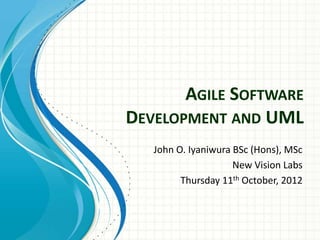Agile software development and UML
- 1. AGILE SOFTWARE DEVELOPMENT AND UML John O. Iyaniwura BSc (Hons), MSc New Vision Labs Thursday 11th October, 2012
- 2. Overview ŌĆó Agile Software Development, What Is It? ŌĆó Agile Methodology, Why Adopt It? ŌĆó Agile Software Development, Main Features ŌĆó UML- Unified Modeling Language ŌĆó Benefits Of Adopting UML ŌĆó UML- Key Components ŌĆó Agile + UML = Pragmatic Software Development ŌĆó Summary ŌĆó References ŌĆó Questions? Agile Software Development With UML 2
- 3. Agile Software Development, What Is It? ŌĆó An approach to developing software ŌĆó February 2001, 17 Software developers, Snowbird, Utah, USA ŌĆó Manifesto for Agile Software Development ŌĆó ŌĆśWe are uncovering better ways of developing software by doing it and helping others do it. Through this work we have come to value: ŌĆó Individuals and interactions over processes and tools Working software over comprehensive documentation Customer collaboration over contract negotiation Responding to change over following a plan ŌĆó That is, while there is value in the items on the right, we value the items on the left moreŌĆÖ. ŌĆó Source: http://agilemanifesto.org/ Accessed: 09/10/2012 Agile Software Development With UML 3
- 4. Agile Methodology, Why Adopt It? ŌĆó Agile software development is: ŌĆó incremental - software not delivered in a ŌĆśbig- bang!ŌĆÖ ŌĆó Iterative - development process repeated many times till the desired end-result is achieved. ŌĆó Flexible- changes from clients are accommodated ŌĆó Adaptable- lean more to right than left & vice-versa ŌĆó Transparent - encourages client/user involvement ŌĆó Simple - easily adopted by development teams Agile Software Development With UML 4
- 5. Agile Software Development, Main Features Agile Software Development With UML 5
- 6. UML ŌĆō Unified Modeling Language ŌĆó ŌĆśThe Unified Modeling LanguageŌäó - UML - is OMG's most-used specification, and the way the world models not only application structure, behavior, and architecture, but also business process and data structure.ŌĆÖ - Object Management Group (OMG) ŌĆó UML ŌĆō ŌĆśa notation, both visual and textual, used to model (i.e. describe) various aspects of software and business systems as well processes.ŌĆÖ ŌĆō John O. Iyaniwura. Agile Software Development With UML 6
- 7. Benefits Of Adopting UML ŌĆó Reduction in time/effort required to enhance software ŌĆó Reduction in cost of correcting errors, i.e. ŌĆśbugsŌĆÖ ŌĆó Reduction in time spent building software: re-use ŌĆó Increase in the quality of delivered software ŌĆó Enables communication as design ŌĆślingua francaŌĆÖ ŌĆó Benefits from automated support, reducing errors/bugs, correctness: CASE tools. Agile Software Development With UML 7
- 8. UML, Key Components ŌĆó UML Structure Agile Software Development With UML 8
- 9. Agile + UML = Pragmatic Software Development ŌĆó Software developed with an agile approach together with UML models results in ŌĆō customer satisfaction through early and continuous delivery of valuable software ŌĆō the accommodation of changing requirements even late in development ŌĆō frequent delivery of working software, from a couple of weeks to a couple of months ŌĆō the promotion of sustainable development ŌĆó The pragmatism of this approach has endeared it to software development teams wary of heavy-weight processes e.g. SDLC, Waterfall, Unified Process etc. Agile Software Development With UML 9
- 10. Summary ŌĆó Agile software development is a light-weight development process ŌĆó Agile software development yields software incrementally and in iterations ŌĆó The Unified Modelling Language (UML) is a notation for creating models of software artefacts ŌĆó UML is globally adopted, supported by CASE tools, and improves software quality ŌĆó The combination of agile software development and UML results in software that more closely meets the requirements of clients Agile Software Development With UML 10
- 11. References ŌĆó Agile Manifesto: http://agilemanifesto.org/ ŌĆó Principles behind Agile development: http://agilemanifesto.org/principles.html ŌĆó The Unified Modeling Language: http://www.uml.org/ ŌĆó Agile Modeling: http://www.agilemodeling.com/ ŌĆó Scrum: http://www.scrum.org/ ŌĆó All last accessed on 09/10/2012 Agile Software Development With UML 11
- 12. Questions? Agile Software Development With UML 12
Editor's Notes
- #2: This template can be used as a starter file for presenting training materials in a group setting.SectionsRight-click on a slide to add sections. Sections can help to organize your slides or facilitate collaboration between multiple authors.NotesUse the Notes section for delivery notes or to provide additional details for the audience. View these notes in Presentation View during your presentation. Keep in mind the font size (important for accessibility, visibility, videotaping, and online production)Coordinated colors Pay particular attention to the graphs, charts, and text boxes.Consider that attendees will print in black and white or grayscale. Run a test print to make sure your colors work when printed in pure black and white and grayscale.Graphics, tables, and graphsKeep it simple: If possible, use consistent, non-distracting styles and colors.Label all graphs and tables.
- #3: Give a brief overview of the presentation. Describe the major focus of the presentation and why it is important.Introduce each of the major topics.To provide a road map for the audience, you can repeat this Overview slide throughout the presentation, highlighting the particular topic you will discuss next.
- #4: This is another option for an Overview slides using transitions.
- #8: This is another option for an Overview slide.












